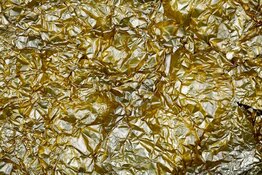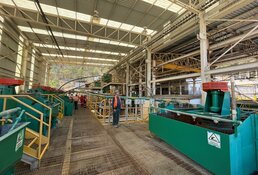The term "critical minerals" has transformed from specialized industry jargon to a household phrase resonating throughout political circles, financial institutions, and across the defense and energy sectors.
These elements form the essential foundation of our technological and manufacturing future — consider gallium essential for computer chips, antimony crucial for military-grade materials, and rare earth elements for magnets powering everything from advanced military aircraft to renewable energy infrastructure.
They've earned their "critical" designation not merely for their importance, but because of the precarious nature of their supply networks. . .
China controls processing for over 80% of global rare earth production. Russia dominates palladium and specialized metals markets. And America? For far too long, it has depended on overseas suppliers for the very materials essential to building durable infrastructure and protecting national interests.
Currently, federal authorities are rushing to develop domestic production, providing financial incentives, collaborative arrangements, and favorable regulatory conditions to potential partners.
And here's what most observers overlook: Many of the most promising sources for these essential minerals aren't dedicated extraction operations. . .
Precious Metal Operations Yield More Than Advertised
The gold and silver mining sector has traditionally been presented as a straightforward enterprise. . .
Extract, blast, refine, market. But geological realities don't conform to corporate strategies.
Mineral deposits rarely exist in isolation underground — they appear in groupings, settled together when mineral-saturated hot fluids cooled within rock fissures and geological breaks millions of years ago.
This explains why silver deposits often contain antimony, gold formations frequently include tellurium, and mixed-metal sites typically harbor gallium, germanium, and indium alongside lead and zinc.
For generations, these additional elements were dismissed as contaminants or quietly processed as secondary considerations. Today, with governmental eagerness to incentivize critical mineral development, they're being recognized as potential windfalls.
The secondary products from precious metal extraction are suddenly becoming primary considerations. Today's gold and silver operations could potentially serve as the foundation for tomorrow's critical mineral distribution network.
Geological Reality: Where These Minerals Hide
The specific relationships between precious metals and critical minerals depend on geological formation types. . .
Epithermal deposits, created through shallow hydrothermal processes, yield abundant gold and silver but frequently contain antimony, arsenic, and tellurium.
Carlin-type formations, which established Nevada as a mining powerhouse, contain microscopic gold particles and have demonstrated significant antimony and mercury.

Polymetallic systems — particularly those centered on lead and zinc — commonly produce silver as a secondary element, and within those ores you'll discover gallium, indium, and germanium, three minerals absolutely essential for semiconductor manufacturing.
Then there are porphyry formations, enormous copper-gold deposits that typically include molybdenum and rhenium. These two elements may not capture headlines, but they're crucial for enhancing steel and constructing aircraft engines.

In essence, a gold or silver site rarely offers "just" precious metals. Each formation type brings with it a collection of critical minerals waiting for extraction.
What the Past Can Teach Us
Past experience demonstrates what happens when these "additional elements" receive proper attention. . .
Idaho's Coeur d'Alene region generated silver for more than 100 years — but simultaneously produced germanium and gallium, two elements that would eventually become vital for electronics and aerospace applications.
And Nevada's renowned Carlin Trend wasn't exclusively a gold producer. . . Its antimony byproducts became strategically important as flame retardants and military alloys gained significance.
Then consider Mexico's silver regions, long considered single-commodity assets, proved rich in tellurium — a previously ignored element now crucial for high-performance solar technology.
Repeatedly, what was once considered waste material has transformed into a source of national advantage. Today's overlooked secondary products are tomorrow's essential resources.
Four Mining Companies Strategically Positioned
This brings us to contemporary operators. . .
Several enterprises with gold and silver projects are ideally situated to deliver not just precious metal ounces, but substantial quantities of critical minerals that America urgently requires.
Each of these companies illustrates that mining operations aren't one-dimensional ventures. Precious metal ounces may dominate financial news, but the secondary elements could represent the true value.
Coeur Mining: Beyond Traditional Precious Metals
Coeur Mining Inc. (CDE:NYSE) represents more than another silver-and-gold producer. With operations throughout America and Mexico, including its premier Rochester site in Nevada, Coeur is establishing itself as a diverse metals powerhouse.
Rochester alone features one of the world's largest heap leach facilities, and while silver and gold represent the primary products, the geological composition indicates secondary lead and zinc production.
This creates opportunities for gallium and germanium — two critical minerals essential for semiconductors, optical fibers, and infrared technology.
For Coeur, what was previously considered background data is rapidly becoming an alternative revenue stream that positions the company as a potential key contributor to America's critical mineral strategy.
I-80 Gold: Nevada's Strategic Advantage
i-80 Gold Corp. (IAU:TSX; IAUX:NYSE) is building recognition as one of Nevada's most promising emerging gold enterprises. . .
Its holdings include Granite Creek, Lone Tree, Ruby Hill, and McCoy-Cove — properties located squarely within the Carlin and Battle Mountain regions, among the most productive gold territories globally.
But Ruby Hill specifically tells a more comprehensive story. . . This site isn't exclusively gold-focused — it's polymetallic, containing zinc, silver, and indicators of antimony, making it a candidate for critical mineral extraction.
With Nevada already established as the core of America's gold industry, I-80 could become a central component in developing the nation's secure mineral supply network.
West Point Gold: Emerging Player, Significant Opportunity
West Point Gold Corp. (WPG:TSXV; WPGCF:OTCQB) may lack the scale of Coeur or I-80, but its properties are situated in regions where gold and copper mineralization intersect.
This matters because copper-gold systems frequently contain molybdenum and rhenium — two minerals with disproportionate importance in aerospace and defense. . .
Molybdenum enhances steel for pipelines and energy facilities, while rhenium is essential for aircraft engines.
For an enterprise like West Point, critical mineral byproducts could significantly enhance its strategic value, transforming a small-cap gold investment into something far more substantial than current market valuations recognize.
Apollo Silver: California's Untapped Potential
Apollo Silver Corp. (APGO:TSX.V; APGOF:OTCQB) is quickly emerging as one of North America's most intriguing silver developers. . .
Its Calico Project in California represents one of America's largest undeveloped silver deposits, with billions in potential underground resources.
Combined with its Cinco de Mayo Project in Mexico, Apollo has considerable exposure to silver price movements.
What makes Apollo particularly fascinating is the potential for barite and zinc within these deposits.
If Apollo can demonstrate economically viable recovery of barite or zinc, it won't merely be a silver developer — it'll represent a critical mineral opportunity as well.
When Precious Metals Join the Critical List
There's also the possibility that gold and silver themselves could join the official critical minerals inventory. Silver is already partially there. . .
The U.S. Department of the Interior has openly suggested its inclusion, acknowledging its role in solar technology, advanced electronics, and defense applications.
Official designation would immediately elevate silver mines to critical status, enabling accelerated permitting and potential federal assistance.
Gold hasn't received this classification yet, but compelling arguments exist. . .
Central banks are accumulating it aggressively as the ultimate reserve asset. Its industrial applications in aerospace, electronics, and medicine only strengthen the rationale.
Should gold ever make the list, every American gold operation would instantly become a strategic asset.
Consider the implications for companies like Coeur, I-80, West Point, and Apollo. . .
Their projects wouldn't merely represent precious metals ventures, which already enjoy a sustained bull market. . .
They'd be redefined as fundamental components of America's critical mineral strategy, too.
The Investment Takeaway: Early Positioning for Maximum Gain
The dialogue surrounding critical minerals now extends beyond rare earths or lithium.
Gold and silver producers are entering the conversation, not just as suppliers of wealth and safe-haven assets, but as hidden sources of minerals essential to technology, energy, and defense advancement.
We've observed this pattern previously — ignored secondary products suddenly become strategic assets, reshaping entire industries.
The enterprises best positioned to capitalize on this trend are those already producing or developing, with projects rich in both precious metals and the minerals Washington desperately seeks.
This represents the kind of market transformation that elevates small-cap mining operations to industry leaders.
Coeur Mining, I-80 Gold, West Point Gold, and Apollo Silver represent four companies already ideally situated at this historical moment.
Investors entering now gain exposure not just to gold and silver, but leverage to a critical minerals expansion that could redefine the entire mining sector.
The optimal timing isn't after government authorities officially designate these operations with "critical" status. By then, the straightforward gains will have disappeared. The time for action is now — before the major market movements truly begin.
| Want to be the first to know about interesting Critical Metals, Gold and Silver investment ideas? Sign up to receive the FREE Streetwise Reports' newsletter. | Subscribe |
Important Disclosures:
- As of the date of this article, officers and/or employees of Streetwise Reports LLC (including members of their household) own securities of West Point Gold Corp.
- Brian Hicks: I, or members of my immediate household or family, own securities of: None. My company has a financial relationship with: None. My company has purchased stocks mentioned in this article for my management clients: None. I determined which companies would be included in this article based on my research and understanding of the sector.
- Statements and opinions expressed are the opinions of the author and not of Streetwise Reports, Street Smart, or their officers. The author is wholly responsible for the accuracy of the statements. Streetwise Reports was not paid by the author to publish or syndicate this article. Streetwise Reports requires contributing authors to disclose any shareholdings in, or economic relationships with, companies that they write about. Any disclosures from the author can be found below. Streetwise Reports relies upon the authors to accurately provide this information and Streetwise Reports has no means of verifying its accuracy.
- This article does not constitute investment advice and is not a solicitation for any investment. Streetwise Reports does not render general or specific investment advice and the information on Streetwise Reports should not be considered a recommendation to buy or sell any security. Each reader is encouraged to consult with his or her personal financial adviser and perform their own comprehensive investment research. By opening this page, each reader accepts and agrees to Streetwise Reports' terms of use and full legal disclaimer. Streetwise Reports does not endorse or recommend the business, products, services or securities of any company.
For additional disclosures, please click here.









































